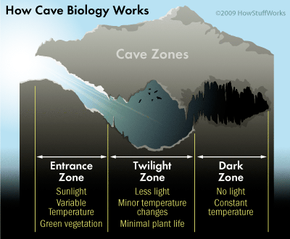Cave Zones
Trogloxenes, troglophiles and troglobites call different parts of the cave home. The environment at the mouth of the cave differs greatly from the environment deep inside the cave. A cave has several zones.
The entrance zone environment is closest to the environment above ground. It receives sunlight and has variable temperatures and green plants. Many animals like raccoons or bears utilize this space to eat their food, sleep or nest. In the entrance zone, you'll find organisms like moss, ferns, owls, snails and salamanders.
Advertisement
Venture a bit farther into the cave to enter the twilight zone. In the twilight zone, there's less light, so plants don't really grow there. The temperature remains a bit more constant but may still fluctuate in conjunction with weather aboveground. Organisms living in the twilight zone need moisture and coolness to survive. Here, you'll find the habitats of many trogloxenes, including moths, bats, spiders, millipedes and mushrooms. The animals found in the twilight zone usually leave and enter the cave at will.
Travel even deeper into the cave to experience the dark zone. In the dark zone, there is no light whatsoever. The temperature remains constant. Troglobites live in the dark zone. These organisms have undeveloped eyes, poor pigment and long antennae because they've adapted to live in this environment.
How do the organisms living in the dark zone survive? What do they eat? Read on to find out.
